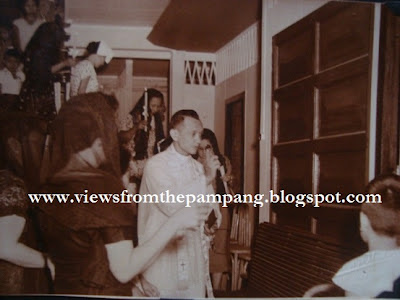BE IT EVER SO HUMBLE. Angeles-born Msgr. Manuel V. Del Rosario and parish priest of San Roque Church of Blumentritt, Sta. Cruz, performs a house blessing for one of his parishioners. Ca. 1950s.
For many Kapampangans, a house is not a home unless it is transformed into a haven of comfort and safety, protected not just from the elements but from the malevolence of this world, where only the goodness of heart reigns. And, like all Filipinos, he takes the extra effort to ward of negative vibes, even before the blueprint is drawn. As such, building beliefs abound, which have, through the years, served as his guidelines in the construction of their dream residences.
First, there is the issue of the house location. A house should not be erected at a dead end street, for that conjures the image of a dagger pointing its way to doorway of the house. It is preferred that houses face the east, so that when one opens the windows, he catches the first rays of the sun, a positive beginning.
Carpenters contracted to build houses were often required to have their tools blessed, invoking their patron San Jose, for guidance, safety and a job well done. In Betis, the instruments of San Jose’s carpentry trade are processioned by male teens together with his image, although not on his feast day, but on the Monday after Easter Sunday.
Master carpenters often had a say on the choice of materials to be used for house construction. Wooden posts should be perfect, devoid of nodes and holes, for it is believed that spirits lurk inside these tree parts. Before the first post is planted into the ground, religious medals and coins are dropped into the hole for divine protection. In rural areas, pig or chicken blood is smeared on house posts, a primitive custom done for the same reason.
Stairways should be oriented towards the east; floor planks should be nailed parallel to the steps of the stairs, not perpendicular. Ceiling boards and floor planks should be laid at right angles to each other, lest death overtakes the resident.
To ensure prosperity and avoid bad luck, the steps of the stairs are counted while intoning the words “Oro, plata, mata” (Gold, silver, death). The last step should end with either “Oro” or “Plata”, but never “Mata”. Again, coins are usually cemented on the bottom stair landing to attract wealth and plenty.
The most auspicious time to transfer into one’s finished house is during the time of a full moon. Tradition dictates that the first objects to be brought into the house are a religious statue and a jar of salt. Salt is sacred to many cultures and figures in many superstitious practices; its purifying and preservative qualities make the mineral a symbol of good and long life.
The house blessing itself, is a cause for major celebration. A priest is specially invited to bless the house, room by room, floor by floor, while candles are lit and prayers are said. The reverend goes around splashing Holy Water on the different sections of the house, followed by a retinue of guests and residents.
At the end of the blessing, the master of the house throws coins to the guests, who scamper to pick them up. With that generous gesture comes a wish for a life of peace and prosperity under a sturdy roof, in a humble place we call home.
Monday, September 24, 2012
*311. BLESS THIS HOUSE
Subscribe to:
Post Comments (Atom)









No comments:
Post a Comment